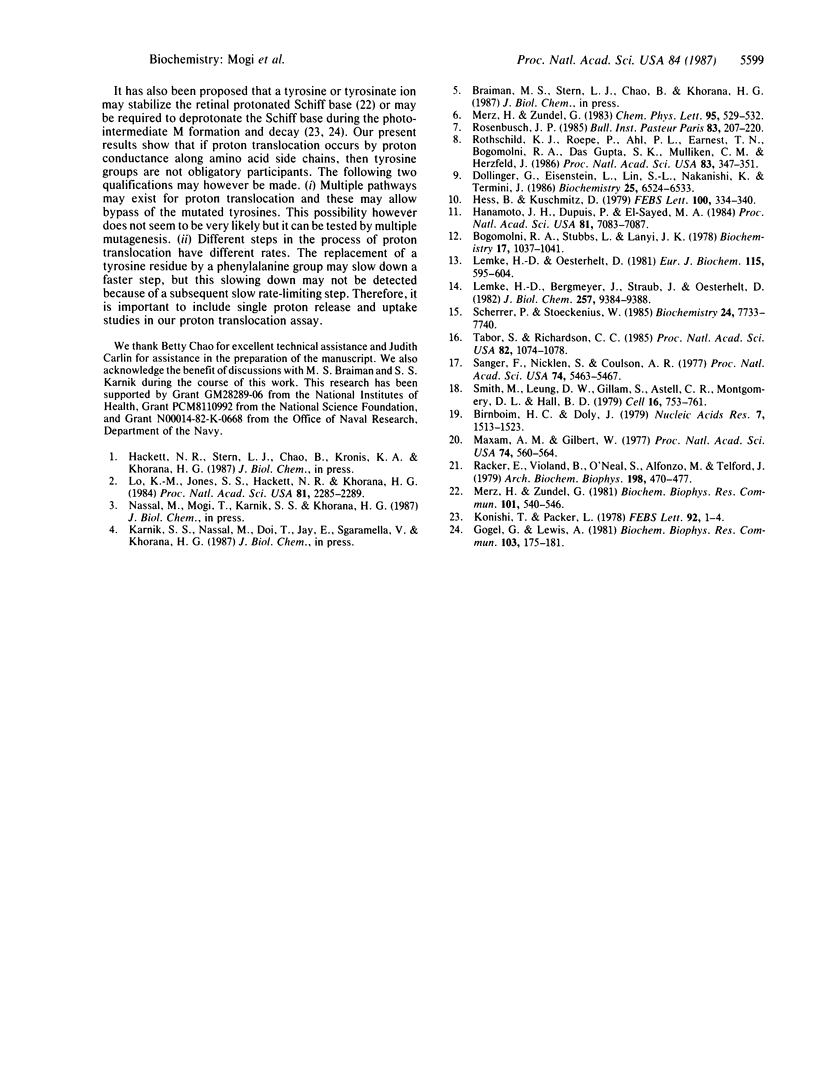Abstract
To study the possible role of the tyrosine residues in proton translocation by bacteriorhodopsin, we have replaced these residues individually by phenylalanine. The required codon changes were introduced in the bacterioopsin gene by replacement of appropriate restriction fragments by synthetic counterparts containing the desired nucleotide changes. The denatured opsin polypeptides obtained by expression of the mutant genes in Escherichia coli were purified and treated with a mixture of detergents, phospholipids, and retinal in a previously established renaturation procedure. All of the mutant proteins folded to regenerate bacteriorhodopsin-like chromophores. Three mutants with tyrosine to phenylalanine substitutions at positions 57, 83, and 185 regenerated the chromophore more slowly than the wild-type protein, and two of these mutants, Phe-57 and -83, showed slightly blue-shifted chromophores. When reconstituted into liposomes all of the mutant proteins with single Tyr----Phe substitutions pumped protons at rates and levels comparable to those of the wild-type bacteriorhodopsin. We conclude that single substitutions of tyrosine by phenylalanine do not affect folding, retinal binding, or light-dependent proton pumping in bacteriorhodopsin.
Full text
PDF




Selected References
These references are in PubMed. This may not be the complete list of references from this article.
- Birnboim H. C., Doly J. A rapid alkaline extraction procedure for screening recombinant plasmid DNA. Nucleic Acids Res. 1979 Nov 24;7(6):1513–1523. doi: 10.1093/nar/7.6.1513. [DOI] [PMC free article] [PubMed] [Google Scholar]
- Bogomolni R. A., Stubbs L., Lanyi J. K. Illumination-dependent changes in the intrinsic fluorescence of bacteriorhodopsin. Biochemistry. 1978 Mar 21;17(6):1037–1041. doi: 10.1021/bi00599a015. [DOI] [PubMed] [Google Scholar]
- Dollinger G., Eisenstein L., Lin S. L., Nakanishi K., Termini J. Fourier transform infrared difference spectroscopy of bacteriorhodopsin and its photoproducts regenerated with deuterated tyrosine. Biochemistry. 1986 Oct 21;25(21):6524–6533. doi: 10.1021/bi00369a028. [DOI] [PubMed] [Google Scholar]
- Gogel G., Lewis A. Effect of iodination on the pK of Schiff base deprotonation and M 412 production in purple membrane. Biochem Biophys Res Commun. 1981 Nov 16;103(1):175–181. doi: 10.1016/0006-291x(81)91676-4. [DOI] [PubMed] [Google Scholar]
- Hanamoto J. H., Dupuis P., El-Sayed M. A. On the protein (tyrosine)-chromophore (protonated Schiff base) coupling in bacteriorhodopsin. Proc Natl Acad Sci U S A. 1984 Nov;81(22):7083–7087. doi: 10.1073/pnas.81.22.7083. [DOI] [PMC free article] [PubMed] [Google Scholar]
- Hess B., Kuschmitz D. Kinetic interaction between aromatic residues and the retinal chromophore of bacteriorhodopsin during the photocycle. FEBS Lett. 1979 Apr 15;100(2):334–340. doi: 10.1016/0014-5793(79)80364-6. [DOI] [PubMed] [Google Scholar]
- Lemke H. D., Bergmeyer J., Straub J., Oesterhelt D. Reversible inhibition of the proton pump bacteriorhodopsin by modification of tyrosine 64. J Biol Chem. 1982 Aug 25;257(16):9384–9388. [PubMed] [Google Scholar]
- Lemke H. D., Oesterhelt D. The role of tyrosine residues in the function of bacteriorhodopsin. Specific nitration of tyrosine 26. Eur J Biochem. 1981 Apr;115(3):595–604. doi: 10.1111/j.1432-1033.1981.tb06244.x. [DOI] [PubMed] [Google Scholar]
- Lo K. M., Jones S. S., Hackett N. R., Khorana H. G. Specific amino acid substitutions in bacterioopsin: Replacement of a restriction fragment in the structural gene by synthetic DNA fragments containing altered codons. Proc Natl Acad Sci U S A. 1984 Apr;81(8):2285–2289. doi: 10.1073/pnas.81.8.2285. [DOI] [PMC free article] [PubMed] [Google Scholar]
- Maxam A. M., Gilbert W. A new method for sequencing DNA. Proc Natl Acad Sci U S A. 1977 Feb;74(2):560–564. doi: 10.1073/pnas.74.2.560. [DOI] [PMC free article] [PubMed] [Google Scholar]
- Merz H., Zundel G. Proton conduction in bacteriorhodopsin via a hydrogen-bonded chain with large proton polarizability. Biochem Biophys Res Commun. 1981 Jul 30;101(2):540–546. doi: 10.1016/0006-291x(81)91293-6. [DOI] [PubMed] [Google Scholar]
- Racker E., Violand B., O'Neal S., Alfonzo M., Telford J. Reconstitution, a way of biochemical research; some new approaches to membrane-bound enzymes. Arch Biochem Biophys. 1979 Dec;198(2):470–477. doi: 10.1016/0003-9861(79)90521-6. [DOI] [PubMed] [Google Scholar]
- Rothschild K. J., Roepe P., Ahl P. L., Earnest T. N., Bogomolni R. A., Das Gupta S. K., Mulliken C. M., Herzfeld J. Evidence for a tyrosine protonation change during the primary phototransition of bacteriorhodopsin at low temperature. Proc Natl Acad Sci U S A. 1986 Jan;83(2):347–351. doi: 10.1073/pnas.83.2.347. [DOI] [PMC free article] [PubMed] [Google Scholar]
- Sanger F., Nicklen S., Coulson A. R. DNA sequencing with chain-terminating inhibitors. Proc Natl Acad Sci U S A. 1977 Dec;74(12):5463–5467. doi: 10.1073/pnas.74.12.5463. [DOI] [PMC free article] [PubMed] [Google Scholar]
- Scherrer P., Stoeckenius W. Effects of tyrosine-26 and tyrosine-64 nitration on the photoreactions of bacteriorhodopsin. Biochemistry. 1985 Dec 17;24(26):7733–7740. doi: 10.1021/bi00347a035. [DOI] [PubMed] [Google Scholar]
- Smith M., Leung D. W., Gillam S., Astell C. R., Montgomery D. L., Hall B. D. Sequence of the gene for iso-1-cytochrome c in Saccharomyces cerevisiae. Cell. 1979 Apr;16(4):753–761. doi: 10.1016/0092-8674(79)90091-6. [DOI] [PubMed] [Google Scholar]
- Tabor S., Richardson C. C. A bacteriophage T7 RNA polymerase/promoter system for controlled exclusive expression of specific genes. Proc Natl Acad Sci U S A. 1985 Feb;82(4):1074–1078. doi: 10.1073/pnas.82.4.1074. [DOI] [PMC free article] [PubMed] [Google Scholar]


